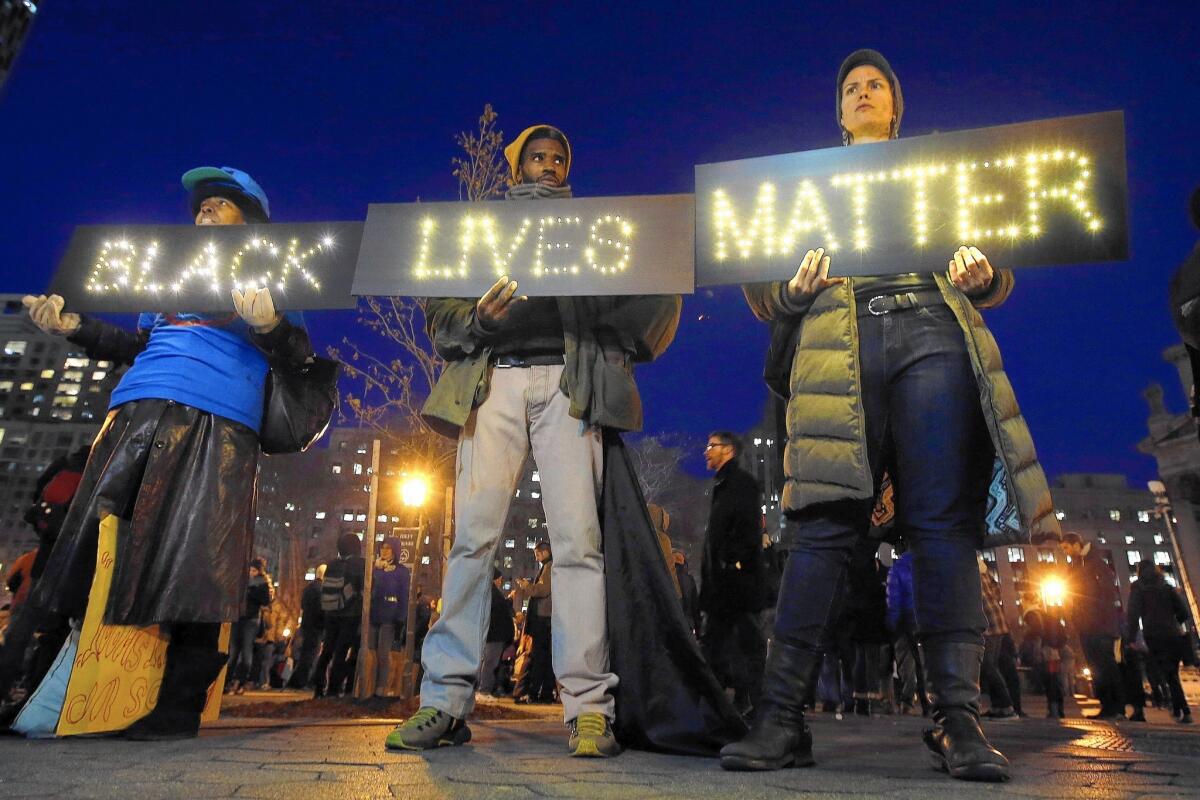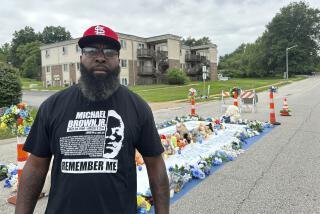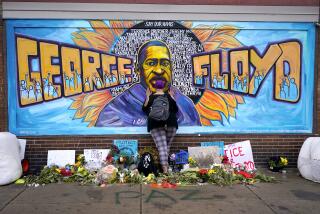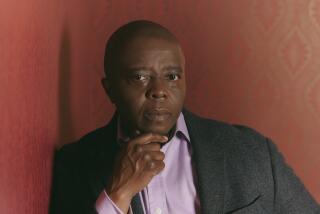Year in Review: In 2014, racial tension over policing reached a breaking point

- Share via
It was a year of grand juries and smashed windows, of tear gas and video evidence, and of boisterous demands for police reform in Los Angeles, New York, Oakland and Ferguson, Mo., as crowds cried, “Black lives matter.”
It was the year in which a black Staten Island, N.Y., man suspected of selling untaxed cigarettes, Eric Garner, died after an altercation with police; the officer accused of putting him in an unauthorized chokehold was not indicted. Ohio police were similarly absolved after fatally shooting John Crawford III in a Wal-Mart after he picked up a BB gun while talking on the phone with his girlfriend. Elsewhere in Ohio, a Cleveland police officer fatally shot a 12-year-old boy who was carrying a toy gun in a park, a death the state medical examiner ruled a homicide.
It was the year two police officers were shot dead in their patrol car in Brooklyn solely because of the uniforms they wore, and of a solemn funeral afterward at which hundreds of New York Police Department officers turned their backs on the mayor of the nation’s largest city, who had said he’d told his mixed-race son to be wary of the police for his own safety.
In city after city, 2014 became a year in which the nation’s lingering racial fissures burst open from the strain of a fundamental disagreement over the nature and purpose of policing, especially in African American communities.
More so than teachers, tax collectors or elected officials, police officers are often the most visible representatives of the government — and its policies — on the streets of black communities across the country, which remain widely disadvantaged both economically and politically.
Eugene O’Neill, a former NYPD officer and prosecutor who is a lecturer at the John Jay College of Criminal Justice, put the role of police in terms of political philosophy: “They use force on people, they are agents of coercion, they are surrogates sent there on our behalf.”
But while the role of officers to use force to protect life and property is a universal feature of American government, polls have shown that the degree of public trust in the police is politically polarized largely by skin color and, to a somewhat lesser extent, political affiliation.
That political friction has long existed in American life, so when black activists this year likened the arrival of widespread protests to a new civil rights movement, their grievances centered on and came face to face with an old foe: the police.
The latest tumultuous chapter in America’s racial history can be traced back to a few moments on Aug. 9.
That’s when 18-year-old Michael Brown, who was black and unarmed, was shot and killed by a white police officer, Darren Wilson, after a struggle and a foot chase through the predominantly black St. Louis suburb of Ferguson.
Officer-involved shootings, even of unarmed victims, happen all the time, but it’s unclear exactly how often, though some estimates put the number at least in the hundreds. Small protests or calls for reform afterward are common.
So why did Ferguson come to be a launching point for months of intense dissent? Some observers pointed to the predominantly black city’s overwhelmingly white political leadership and police force, both of which were quickly overwhelmed by the duration and intensity of the protests that claimed its streets.
Then there was the high drama of St. Louis-area police agencies using tear gas and intimidating force in failing to quell often, but not always, peaceful demonstrations, in which every passing day seemed to bring some kind of escalation.
Missouri Gov. Jay Nixon, who ordered a state of emergency and twice called in the state National Guard, created a commission to study the roots of Ferguson’s civic crisis.
Outgoing U.S. Atty. Gen. Eric H. Holder Jr., who is black, took a special interest in Ferguson, to the pique of some police unions who thought he was being too critical of ground-level law enforcement.
Federal officials descended on the suburb to open an investigation into the shooting and the practices of local police departments; the U.S. Justice Department also will continue to investigate various police departments to check for patterns of civil rights violations.
A running theme in the year’s debate over policing has been understanding — or the lack of it.
Protesters in Ferguson and elsewhere repeatedly said police and the rest of officialdom do not understand the pressures, challenges and dangers facing black Americans.
“Insurance is high, gas is high, but that’s not why I get mad,” Ferguson demonstrator Ricky Jones, 34, said during one of the first nights of the uprising in August. “At the end of the day, when I’m driving home, they ask me to pull over and get out of the car. No ‘license and registration, please.’ ‘Get out of the car. Lay on the ground. Put your hands on your head.’”
Police, for their part, say they are misunderstood too.
“There is a very pervasive feeling in law enforcement ... that the politicians are not supporting us,” said Chuck Canterbury, national president of the Fraternal Order of Police, which has 325,000 members. “Law enforcement is the only arm of government that is ever asked to do anything about [troubled] communities. The politicians are the ones saying, ‘Get in there and stop that crime.’ And then, when an incident happens, they rush to judgment that police were wrong.”
The opposing accounts of what happened the day Michael Brown died seem to capture the divide that will no doubt continue as debate continues on tactics, body cameras and shooting investigations.
Some witnesses said Brown had his hands up when he was shot. Wilson told investigators Brown was charging at him to attack.
It was a basic disagreement of fact that would foreshadow the much larger debate looming for the nation — on what it means to be black in America, or to be a police officer in America, in which voices from both sides would claim to be betrayed and, most of all, deeply misunderstood.
More to Read
Sign up for Essential California
The most important California stories and recommendations in your inbox every morning.
You may occasionally receive promotional content from the Los Angeles Times.











